
Detail of the dolphin support on the card table illustrated in fig. 7. (Photo, Gavin Ashworth.)

Eduardo La Plante (b. 1818), Trinidad visit general tomada desde la loma de La Vigia, 1852. Oil on canvas. 74 5/8" x 63 3/4". (Courtesy, Museo de Bellas Artes de Cuba, Havana.) This painting depicts Trinidad from the vantage point of La Vigia, a hilltop north of the town. Visible on the left side of the picture in the distance is the main road leading from Trinidad to Casilda, where cargo ships can be seen at anchor in the harbor.

A New Chart of the Seas Surrounding the Island of Cuba, with the Soundings, Currents, Ships Courses &c. And a Map of the Island itself, lately made by an Officer in the Navy, illustrated in The London Magazine, 1762. (Courtesy, Map Division, New York Public Library.) Trinidad is located on Cuba’s south shore to the east of the Gulf of Jagua.

One of a pair of card tables attributed to Charles-Honoré Lannuier, New York City, possibly 1819. Mahogany and mahogany veneer with white pine; gilded gesso, vert antique, gilded cast brass, and die-stamped brass banding. Dimensions not recorded. (Courtesy, Museo de Artes Decorativas, Santa Clara, Cuba.) The upper leaf of the table is a replacement, and the die-stamped brass banding on the lower edge of the apron is missing. The ornament on the center of the apron matches one on the plinth of the card table illustrated in fig. 17. Visible on the base of the lyre is the shadow outline of an original cast brass gilded ornament, which was identical to that at the base of the lyre on the card table shown in fig. 15.

Emilio Piani (b. ca. 1812), Un Ingenio en Cuba, 1839. Oil on canvas. 29 3/8" x 36 3/8". (Courtesy, Museo de Bellas Artes de Cuba, Havana.) This picture depicts a typical nineteenth-century Cuban ingenio before the introduction of steam power mills. At the center of the picture is the mill and boiling house. Driven by oxen, the mill pressed the juice out of the freshly cut cane. The extracted juice was then boiled to produce syrup and poured into clay jars to dry. Holes in the bottoms of the jars allowed the darkest, thickest liquid (molasses) to settle while the remainder hardened into a sugar cone. Standing and lounging by a pile of firewood are criollo overseers or technicians and two slaves. The building to the left may be the home of the owner or the manager of the ingenio. Distant plumes of smoke on the left mark the sites of other ingenios.

One of a pair of card tables attributed to Charles-Honoré Lannuier, New York City, possibly 1819. Mahogany and mahogany veneer with white pine, ash, and possibly basswood; gilded gesso, vert antique, gilded cast brass, and die-stamped brass banding. H. 30 3/4", W. 36", D. 17 7/8". (Chipstone Foundation; photo, Gavin Ashworth.) This table is shown after conservation in fig. 7, and its mate is illustrated in fig. 11.
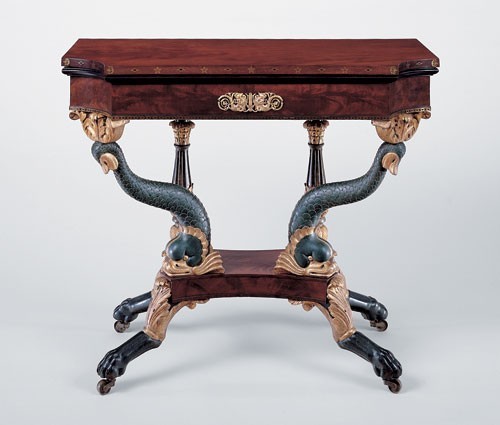
Post-conservation view of the card table illustrated in fig. 6. (Photo, Gavin Ashworth.) Conservation revealed the original decorative scheme of gilding and vert antique on the dolphins, rear columns, and feet. The fluted shafts of the back columns are a mottled yellow-green, which gives the effect of faux marbre or excavated, partially gilded, antique bronze. The bodies of the dolphins are painted a pure sea green with brightly burnished water-gilding on the head. The feet and acanthus corners are oil-gilded with a matte surface.

Detail from page 2 of the estate inventory of Charles-Honoré Lannuier, New York City, October 25, 1819. (Courtesy, Winterthur Museum Library, Joseph Downs Collection of Manuscripts and Printed Ephemera.)

Charles-Honoré Lannuier worktable, New York City, 1817. Mahogany and mahogany veneer with white pine and yellow poplar; gilded gesso and vert antique, gilded cast brass, and die-stamped brass banding. H. 30 5/8", W. 22", D. 17 1/8". (Courtesy, Winterthur Museum; gift of Henry Francis du Pont.)

One of a pair of card tables attributed to Charles-Honoré Lannuier, New York City, possibly 1819. Mahogany and mahogany veneer with white pine; gilded gesso and vert antique. Dimensions not recorded. (Courtesy, Museo Romántico, Trinidad, Cuba.) The table originally had a hinged, two-part top that pivoted 90° and opened for use as a card table.

One of a pair of card tables attributed to Charles-Honoré Lannuier, New York City, possibly 1819. Mahogany and mahogany veneer with white pine and yellow poplar; gilded gesso and vert antique. Dimensions not recorded. (Courtesy, Museo de Artes Decorativas, Santa Clara, Cuba.) The original cast brass gilded ornament, die-stamped brass banding, and inlaid stars and anthemions on the lower edge of the apron and the front edge of the upper leaf are all missing (see fig. 7). The hinged top may be a replacement.

One of a pair of encoignures (corner tables) attributed to Charles-Honoré Lannuier, New York City, possibly 1819. Mahogany and mahogany veneer with white pine; gilded gesso, vert antique, gilded cast brass, and marble. Dimensions not recorded. (Courtesy, Museo de Artes Decorativas, Santa Clara, Cuba.) Originally this encoignure and its mate had marble tops, fragments of which are retained by the museum. The center ornament on the apron, which was identical to the one on the card table illustrated in fig. 7, has lost its outer terminating volutes. The lower edge of the apron most likely had the same lozenge-patterned, die-stamped brass banding as the card table.

Detail of the dolphin support on the encoignure illustrated in fig. 12.

Detail of the painting illustrated in fig. 2 showing, in the center, the neoclassical mansion of Juan Guillaume Béquer with its prominent domed quinta, or tower. Visible immediately to the right is the two-storey rectangular quinta of another mansion in the Spanish colonial style. The latter residence belonged to Justo Cantero, Béquer’s rival in the sugar trade.

Card table attributed to Charles-Honoré Lannuier, New York City, 1815–1819. Mahogany and mahogany veneer with white pine, yellow poplar, and cherry or maple; gilded gesso, vert antique, gilded cast brass, and die-stamped brass banding. H. 31", W. 36", D. 17 7/8". (Private collection; photo, Bruce White.)

Plate 5 from The New-York Book of Prices for Manufacturing Cabinet and Chair Work, 1817. (Courtesy, New-York Historical Society.)
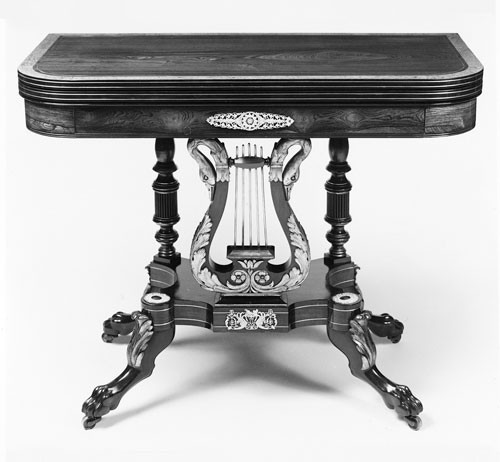
Card table, possibly by Duncan Phyfe, New York City, ca. 1820. Rosewood veneer with white pine and yellow poplar; gilded gesso, vert antique, gilded cast brass, and brass stringing. H. 30", W. 36", D. 18". (Courtesy, Hirschl & Adler Galleries, Inc.) The reeded drums on the back columns occur on furniture documented to Phyfe, and the carved feet are similar in design and workmanship to those on a card table with his label and the date 1820.

Worktable attributed to Charles-Honoré Lannuier, New York City, 1815–1819. Mahogany and mahogany veneer with white pine and yellow poplar; gilded cast brass and brass stringing. H. 32 1/4", W. 23 3/4", D. 17 5/8". (Private collection; photo, Bruce White.)

Michael Allison, worktable, New York City, 1823. Mahogany and mahogany veneer with yellow poplar. H. 29 3/4", W. 28 1/8", D. 15 1/2". (Courtesy, Metropolitan Museum of Art, Rogers Fund, 1933.)

Grecian sofa, New York City, ca. 1820. Mahogany and rosewood veneer with ash and maple or cherry; gilded gesso, vert antique, gilded stamped brass, and die-stamped brass. H. 34 1/2", W. 98 1/2", D. 27". (Courtesy, Metropolitan Museum of Art, Friends of the American Wing Fund, 1965.)

Card table attributed to Barzilla Deming and Erastus Bulkley, New York City, ca. 1825. Rosewood and satinwood veneer with white pine; gilded gesso and vert antique. H. 30", W. 37 1/8", D. 18 1/2". (Private collection; photo, Gavin Ashworth.)
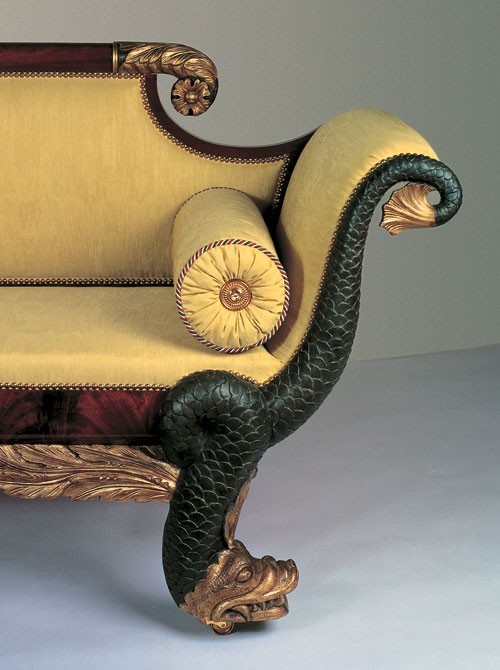
Detail of a Grecian sofa, New York City, ca. 1820. (Courtesy, Hirschl & Adler Galleries, Inc.)

Detail of the bottom edge of the front apron on the card table illustrated in fig. 7 showing the unused rectangular mortise originally planned for a winged caryatid support. (Photo, Gavin Ashworth.)
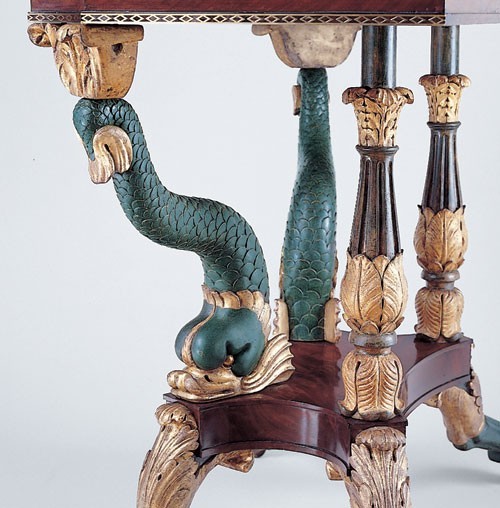
Detail of the card table illustrated in fig. 7 showing the way the dolphin’s body curves to the right as it extends to meet the incurvate corner of the table. (Photo, Gavin Ashworth.)

View of the card table illustrated in fig. 21 showing the straight bodies of the dolphins and canted volutes of their tails.

Grecian sofa, New York City, 1815–1820. Mahogany and mahogany veneer; gilded gesso, vert antique, and brass stringing. Dimensions not recorded. (Courtesy, Hirschl & Adler Galleries, Inc.)

Detail of a caryatid support on a card table by Charles-Honoré Lannuier, New York City, 1817. Mahogany and mahogany veneer with white pine, yellow poplar, ash, and basswood; gilded gesso, vert antique, gilded cast brass, and die-stamped brass banding. H. 31 1/8", W. 36", D. 17 3/4". (Courtesy, Metropolitan Museum of Art, gift of Justine VR Milliken, 1995; photo, Bruce White.) This style of winged caryatid may be the earliest type produced in Lannuier’s shop. This table is one of a pair.

Detail of a caryatid support on a card table attributed to Charles-Honoré Lannuier, New York City, 1815–1819. (Private collection; photo, Gavin Ashworth.) This style of caryatid appears to be transitional. The original cast-brass gilded ornament and lower die-stamped brass border on the apron, which has been replaced by a flat strip of brass, are missing. The tips of the innermost seven feathers on the figure’s left wing are replacements. This table is one of a pair.
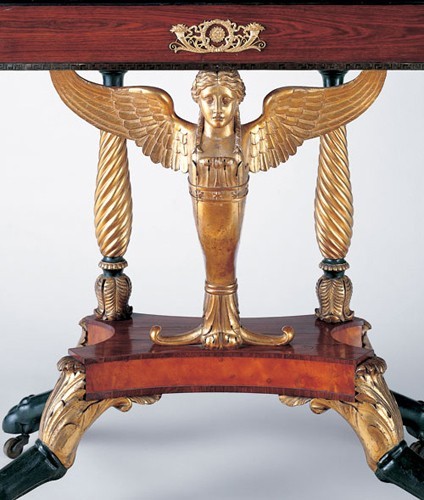
Detail of a caryatid support on a card table attributed to Charles-Honoré Lannuier, New York City, 1817. (Courtesy, Metropolitan Museum of Art, Funds from various donors, 1996; photo, Gavin Ashworth.) This style of winged caryatid appears to be the last produced in Lannuier’s shop.
